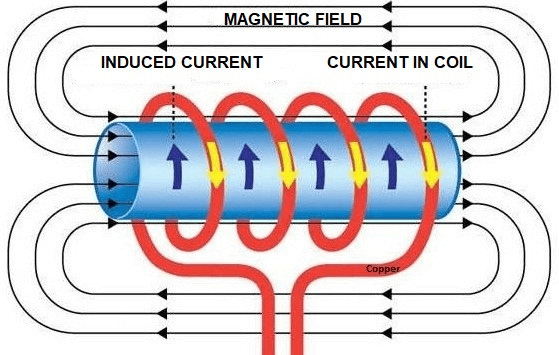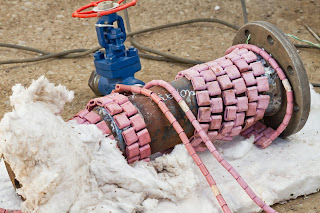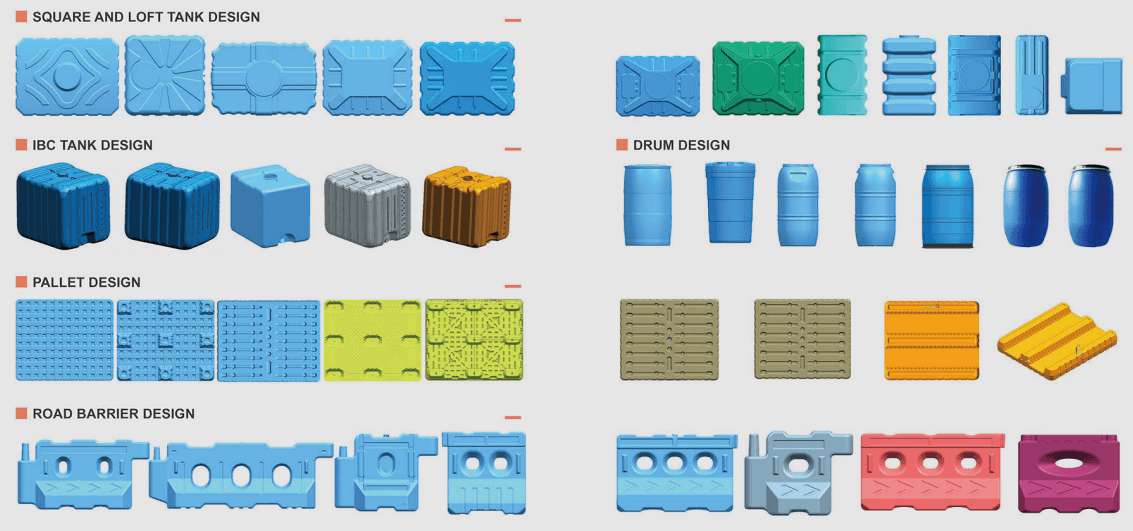(1) The Working Principle of Electromagnetic Induction Heating in Blow Molding Machines
① Electromagnetic Heater
An electromagnetic heater is a device that converts electrical energy into thermal energy using the principle of electromagnetic induction. The electromagnetic heating controller rectifies 220V, 50/60Hz AC power into DC and transforms that DC into high-frequency, high-voltage electricity with a frequency of 20-40kHz. It also converts 380V, 50/60Hz three-phase AC into DC and then into high-frequency, low-voltage, high-current electricity ranging from 10-30kHz, which is used to heat blow-molded products.
② Electromagnetic Heating Coil
When high-frequency, high-voltage current flows through the coil, it generates a rapidly changing alternating magnetic field. When a ferrous container is placed on top, the surface of the container cuts through the alternating magnetic field lines, inducing alternating current (also known as eddy current) in the metal part at the bottom of the container. This eddy current causes the iron atoms at the bottom of the container to move rapidly and chaotically, leading to collisions and friction that generate heat. Essentially, this method transforms electrical energy into magnetic energy, creating induced eddy currents on the surface of the heated steel. This approach fundamentally addresses the inefficiencies associated with heating methods like heating plates and heating coils that rely on thermal conduction.

(2) The Disadvantages of Traditional Resistance Heating
① Significant Heat Loss
The common heating method today involves winding resistance wires that heat up on both the inner and outer surfaces. The heat from the inner side (which is in close contact with the material cylinder) is conducted to the cylinder, while most of the heat from the outer side dissipates into the air, leading to direct energy loss and waste.
With a large amount of heat escaping, the surrounding environment’s temperature rises, which is especially problematic in summer, affecting the production environment significantly. In some cases, the on-site working temperature has exceeded 45°C, forcing some companies to use air conditioning to lower the temperature, resulting in secondary energy waste.
② Short Lifespan and High Maintenance
Electric heating tubes use resistance wires to reach heating temperatures of around 300°C, which leads to significant thermal lag and makes precise temperature control difficult. The resistance wires are prone to aging and breaking due to high temperatures, resulting in a relatively high maintenance workload.

(3) The Advantages of High-Frequency Heating for Blow Molding Products
① Long Lifespan
Electromagnetic heating generates minimal heat from the coils themselves, leading to a long lifespan with no need for repairs or maintenance, and no replacement costs. The heating component uses a ring-shaped cable structure that does not produce heat and can withstand temperatures above 500°C, with a lifespan of up to 10 years.
② Safe and Reliable
The outer wall of the blow molding machine’s material cylinder heats up through high-frequency electromagnetic action, making full use of the heat with almost no loss. The heat is concentrated within the heating body, and the surface temperature of the electromagnetic coil is slightly above room temperature, allowing for safe touch without the need for high-temperature protection—it’s safe and reliable.
③ Efficient and Energy-Saving
Using internal heating methods, the molecules within the heating body directly sense magnetic energy to generate heat, resulting in very fast thermal activation. The average preheating time is reduced by over 60% compared to electric heating methods while achieving thermal efficiency of over 90%. Under the same conditions, it saves 30% to 70% more electricity compared to electric heating, significantly improving energy efficiency.
④ Accurate Temperature Control
The coil itself doesn’t generate heat, and has low thermal resistance and low thermal inertia, ensuring that the temperature on the inside and outside walls of the material barrel is consistent. Temperature control is real-time and precise, significantly improving product quality and boosting production efficiency.

⑤ Excellent Insulation
The electromagnetic coil is made from a specialized high-temperature, high-pressure cable, providing superior insulation. There’s no need for direct contact with the outer wall, eliminating any risk of electric leakage or short circuits, so safety is guaranteed.
⑥ Improved Working Environment
The blow molding machine, modified with electromagnetic heating equipment, utilizes internal heating. This means heat is concentrated within the heating element, with minimal heat dissipation to the outside (almost negligible). The ambient temperature drops from over 100°C during electric heating to room temperature, greatly enhancing the working conditions on the production floor.
⑦ Energy Saving Analysis
How does the electromagnetic heater save 30% to 70% of energy on the blow molding machine?
a. Compared to resistance heating, the electromagnetic heater has an additional insulation layer, increasing thermal energy utilization.
b. Unlike resistance heating, the electromagnetic heater directly heats the material tube, reducing energy loss from heat transfer.
c. The heating speed of the electromagnetic heater is over 25% faster than resistance heating, cutting down heating time.
d. With a faster heating speed compared to resistance heating, production efficiency increases, keeping the motor in a saturated state and reducing energy loss caused by high power with low demand.
In the traditional heating industry, we typically rely on resistance wires and quartz heating methods, but let me tell you, these old-school heating techniques are about as efficient as a screen door on a submarine. Resistance wires and quartz heat up when electricity flows through them, and then they pass that heat onto the barrel to warm up the material. But guess what? The maximum heat utilization rate is only 50%! That means the other half of the heat is just chilling in the air, leading to energy losses of over 50% with these traditional electric heating methods.
Now, let’s talk about electromagnetic induction heating. This bad boy generates a magnetic field through electric current, causing the iron pipes to heat themselves up. Plus, with some insulation materials thrown in, it keeps that heat from escaping. We’re talking about a heat utilization rate of over 95%! Theoretically, you could save more than 50% on your electricity bill. But hold up! Different quality electromagnetic induction controllers have varying energy conversion efficiencies, and the production equipment and environment play a role too. So, in reality, you can expect energy savings of at least 30%, with some setups hitting as high as 70%.
Looking at the recent applications of electromagnetic induction heating in hollow blow molding machines, the energy-saving effects are especially pronounced in medium to large heads. This technology is a game-changer, especially for multi-layer and super-sized heads. When you’re heating that head from a cold state to operational status, the energy savings are clear as day. You can usually cut the heating time by more than half, and the heating effect is just better overall.
So, when you’re ordering new blow molding machines, make sure to hit up the manufacturers at Yankang to get yourself a custom energy-saving setup with this cutting-edge electromagnetic induction heating technology.
